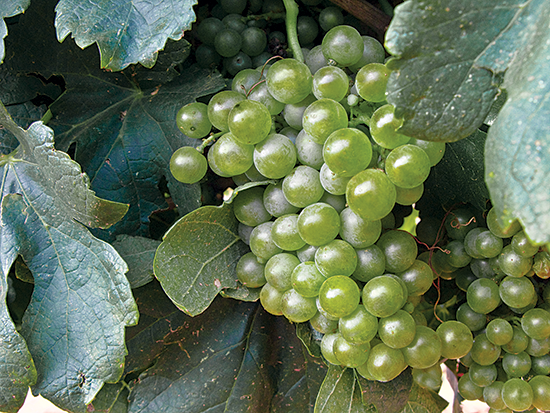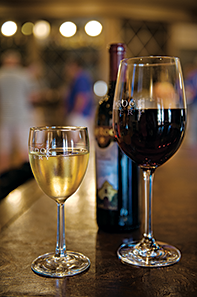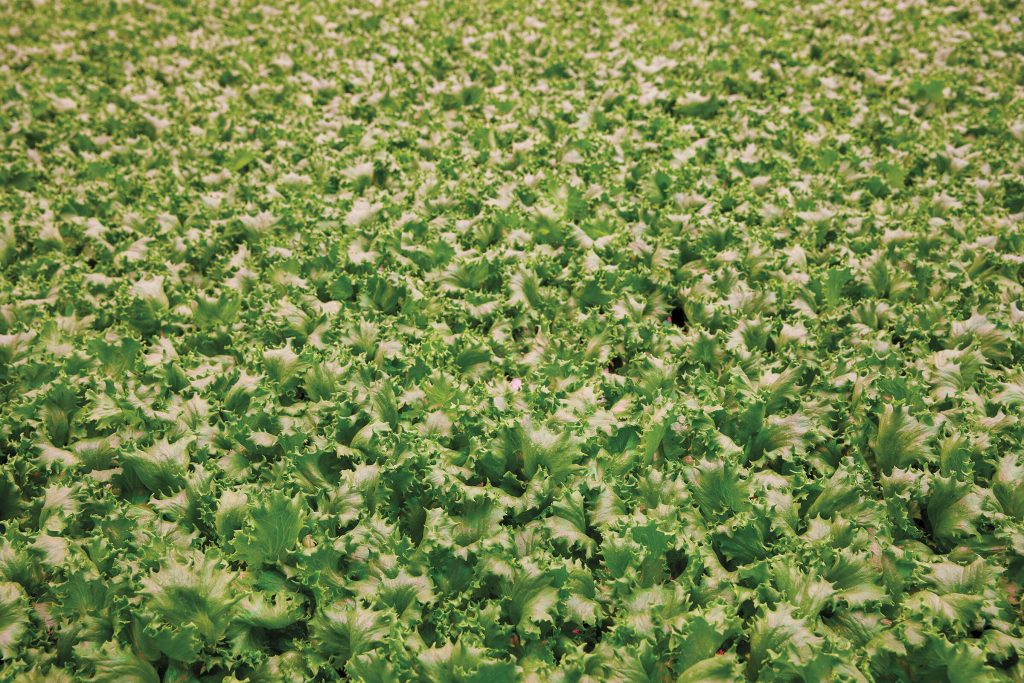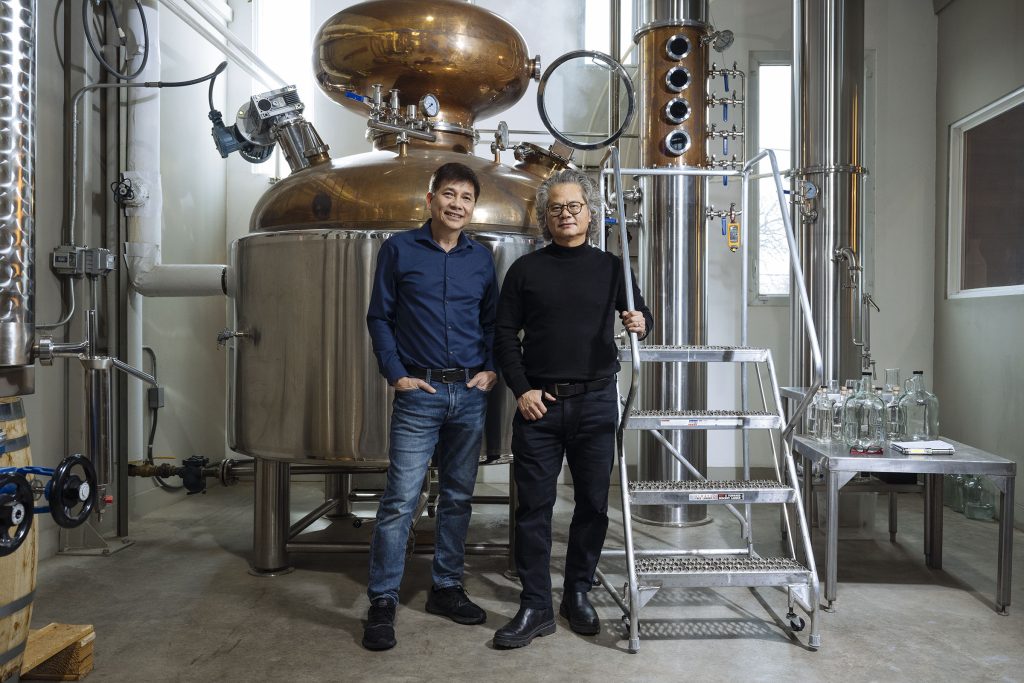
Wine grapes grow well in Texas High Plains due to the soil composition, high elevation and semi-arid climate. (Photo by J. Griffis Smith)
A six-foot steel sculpture of a corkscrew marks the entrance to McPherson Cellars in downtown Lubbock. Inside, the modern theme continues in a sleek tasting room with dark walls, polished floors, and local artwork.
Outside in the courtyard, bright red and blue brick walls, geometric metal cutouts, and low benches topped with vibrant cushions make it clear this is a different kind of winery. No faux-French chateâu here.
Owner Kim McPherson explains that the building housed a Coca-Cola bottling plant from the 1930s to 1960s. Now, McPherson Cellars offers samples of the liquid assets of the Texas High Plains, one of the state’s most important grape-growing regions.
With elevations of 3,000 to 4,100 feet above sea level and a semi-arid climate, the High Plains are ideal for growing grapes. More than half of the wine grapes grown in Texas come from the High Plains, one of eight regions in the state classified as an American Viticultural Area and the state’s second-largest wine appellation next to the Texas Hill Country.
The concentration of vineyards and wineries makes for a “grape escape” opportunity to see the vines, meet the winemakers, and, of course, taste the fermented fruits of their labor. CapRock Winery, Llano Estacado Winery, McPherson Cellars, and Pheasant Ridge Winery operate tasting rooms in the Lubbock area—the perfect base camp for a visit to the High Plains wine country.
Kim went through the enology and viticulture program at the University of California, Davis—one of the nation’s premier training venues for vintners.
After working a few years in Napa Valley, he returned to Lubbock to make wine for Llano and CapRock. In 2008, Kim opened his own McPherson Cellars, which focuses on Rhone Valley, Italian, and Spanish varietals.
One of my favorite McPherson wines is the dry white viognier, which imparts flavors of honeysuckle, orange blossom, and peaches. “Viognier should be our state grape,” Kim says, noting that it grows well throughout Texas.
I also sipped some 2012 vin gris, a dry rosé that tastes of berries and plums. All that was lacking was a pairing with some Gulf shrimp. For that, you can head across the street to La Diosa Cellars, a bistro owned by Kim’s wife, Sylvia, for Spanish-style fare paired with local wines.
Kim practically has wine flowing in his blood. His father, “Doc” McPherson, was one of Llano Estacado’s founders. The High Plains’ transformation into the “Grape Plains” began in 1971, when Texas Tech horticulturist Bob Reed started experimenting with growing grapes. The first commercial planting took place three years later, when Reed and fellow Texas Tech professors Roy Mitchell and Doc McPherson formed the Sandy Land Grape Growers Association. In 1976, the trio founded Llano Estacado Winery. It became a catalyst for Texas’ nascent wine industry.

(Photo by Kevin Stillman)
Nowadays, the Texas High Plains are full of trellised vineyards, including Newsom Vineyards, near the town of Plains and the New Mexico state line. Neal Newsom and his son Nolan provide about 300 tons of grapes annually to wineries such as Llano Estacado. Neal and his wife, Janice, also operate the Rock’n-N Bed & Breakfast, where guests can stay in a historic ranch house and walk over to tour the vineyard.
The major wineries in Lubbock are situated to the north and south of town, including boutique winemaker Pheasant Ridge, whose decades-old vineyard grows cabernet sauvignon, merlot, cabernet franc, pinot noir, chardonnay, chenin blanc, and semillon grapes.
Pheasant Ridge makes French-style wines and produces only about 2,000 cases a year. In a tasting room stacked with wine barrels, I joined other visitors at the wooden bar to sample some of Pheasant Ridge’s estate-grown wines. The star for me was Pheasant Ridge’s cabernet sauvignon, in which I detected flavors of black cherries, currants, blackberries, chocolate, and tobacco.
A 10-mile drive south of town leads to the brilliant green vineyards of CapRock Winery, an elegant Mission-style structure with an arched entrance. In the sumptuous tasting room, outfitted with leather couches and a fireplace, I sampled several wines and chose a bottle of full-bodied “Toscano Rosso” red with hints of coffee and vanilla, cherry, and—as the label teases—“perhaps a hint of West Texas dust.”
Nearby, amid red earth cotton fields, sprawls Llano Estacado Winery, which produces about 170,000 cases a year—so many that it’s easy to find Llano Esta-cado wines in restaurants, convenience stores, supermarkets, and wine shops across Texas. The tasting room offers more than 30 different varieties, from reds and whites to blushes and ports.
This year, though, Greg Bruni, Llano’s vice president and executive winemaker, says he’s especially proud of a small-batch wine called “1836,” a syrah-cabernet sauvignon blend that honors Texas’ independence. It’s clear that the High Plains vintners are pushing their craft, with some delightful results.
In fact, Greg says that he believes “the best wines of Texas haven’t been made yet.” I agree, and I’m happy to keep venturing out to the Grape Plains to measure—and taste—the winemakers’ progress.








